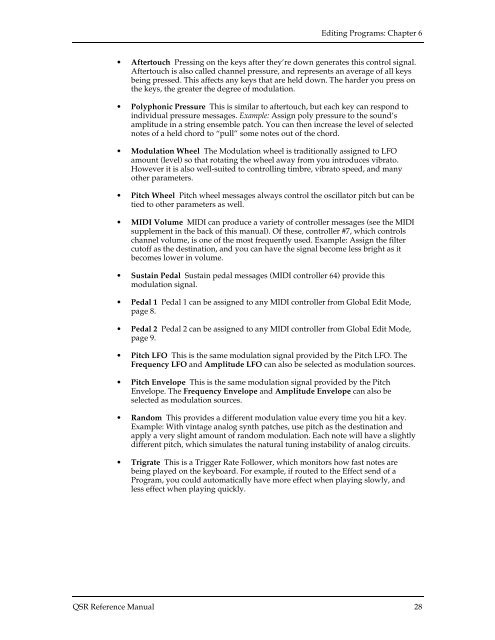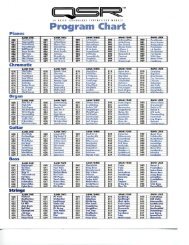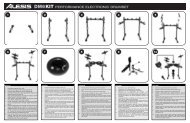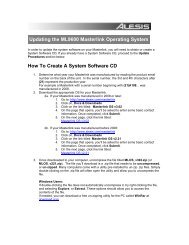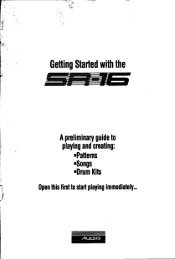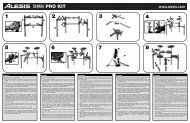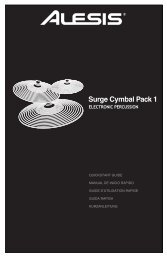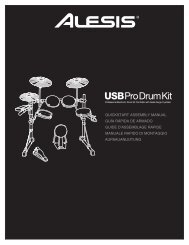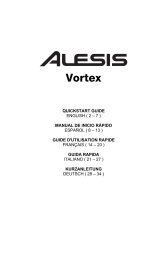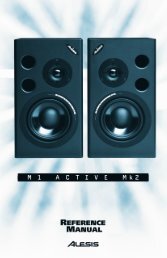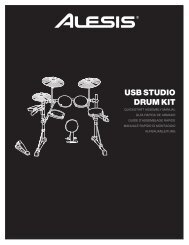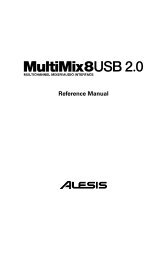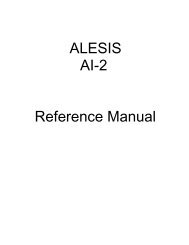QSR Reference Manual - Alesis
QSR Reference Manual - Alesis
QSR Reference Manual - Alesis
- No tags were found...
You also want an ePaper? Increase the reach of your titles
YUMPU automatically turns print PDFs into web optimized ePapers that Google loves.
Editing Programs: Chapter 6• Aftertouch Pressing on the keys after they’re down generates this control signal.Aftertouch is also called channel pressure, and represents an average of all keysbeing pressed. This affects any keys that are held down. The harder you press onthe keys, the greater the degree of modulation.• Polyphonic Pressure This is similar to aftertouch, but each key can respond toindividual pressure messages. Example: Assign poly pressure to the sound’samplitude in a string ensemble patch. You can then increase the level of selectednotes of a held chord to “pull” some notes out of the chord.• Modulation Wheel The Modulation wheel is traditionally assigned to LFOamount (level) so that rotating the wheel away from you introduces vibrato.However it is also well-suited to controlling timbre, vibrato speed, and manyother parameters.• Pitch Wheel Pitch wheel messages always control the oscillator pitch but can betied to other parameters as well.• MIDI Volume MIDI can produce a variety of controller messages (see the MIDIsupplement in the back of this manual). Of these, controller #7, which controlschannel volume, is one of the most frequently used. Example: Assign the filtercutoff as the destination, and you can have the signal become less bright as itbecomes lower in volume.• Sustain Pedal Sustain pedal messages (MIDI controller 64) provide thismodulation signal.• Pedal 1 Pedal 1 can be assigned to any MIDI controller from Global Edit Mode,page 8.• Pedal 2 Pedal 2 can be assigned to any MIDI controller from Global Edit Mode,page 9.• Pitch LFO This is the same modulation signal provided by the Pitch LFO. TheFrequency LFO and Amplitude LFO can also be selected as modulation sources.• Pitch Envelope This is the same modulation signal provided by the PitchEnvelope. The Frequency Envelope and Amplitude Envelope can also beselected as modulation sources.• Random This provides a different modulation value every time you hit a key.Example: With vintage analog synth patches, use pitch as the destination andapply a very slight amount of random modulation. Each note will have a slightlydifferent pitch, which simulates the natural tuning instability of analog circuits.• Trigrate This is a Trigger Rate Follower, which monitors how fast notes arebeing played on the keyboard. For example, if routed to the Effect send of aProgram, you could automatically have more effect when playing slowly, andless effect when playing quickly.<strong>QSR</strong> <strong>Reference</strong> <strong>Manual</strong> 28


